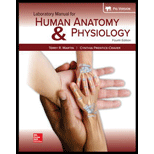
Concept explainers
Which of the following is not a function of connective tissues?
- fill spaces
- provide support
- bind structures together
- body movement
Introduction :
The connective tissue is abundantly distributed in the body. The fibers, ground substance, and cells together constitute the connective tissue. The extracellular matrix consists of fibers and ground substance. The major components of connective tissue vary from one organ to another organ. The connective tissue is divided into specialized and soft connective tissue. The connective tissue function is to provide insulation, protection, binding, storage of reserve fuel and transporting substances.
Answer to Problem 1PL
Correct answer :
The correct answer is option (d) body movement.
Explanation of Solution
Explanation/justification for the correct answer :
Option (d) body movements. The connective tissue provides support, fills spaces and binds the structure together. The muscle tissue is involved in body movements. The stimulus allows muscle tissue to contract and allow body movement. So, the correct answer is an option (d).
Explanation for incorrect answer :
Option (a) fills spaces. The space between different tissues and organs is filled with connective tissue. The space between fibers of the muscle, around lymph and blood vessels, are filled with connective tissue. This filled space provides metabolic and structural support to various organs and tissues. The connective tissue is divided into specialized and soft connective tissue.
Option (b) provides support. The framework and support for the body are provided by connective tissue. For example- cartilage and bone, both provide strength and support to the body. So, this is an incorrect answer.
Option (c) binds structures together. The connective tissue binds the structure together. For example- loose connective tissue connects epithelial tissue to underlying tissues. The connective tissue also holds organs at their place. So, this is an incorrect option.
Want to see more full solutions like this?
Chapter 9 Solutions
Laboratory Manual For Human Anatomy & Physiology
Additional Science Textbook Solutions
Biological Science (6th Edition)
HUMAN ANATOMY
Campbell Essential Biology (7th Edition)
Genetics: From Genes to Genomes
Biology: Life on Earth with Physiology (11th Edition)
- What is behavioral adaptarrow_forward22. Which of the following mutant proteins is expected to have a dominant negative effect when over- expressed in normal cells? a. mutant PI3-kinase that lacks the SH2 domain but retains the kinase function b. mutant Grb2 protein that cannot bind to RTK c. mutant RTK that lacks the extracellular domain d. mutant PDK that has the PH domain but lost the kinase function e. all of the abovearrow_forwardWhat is the label ?arrow_forward
- Can you described the image? Can you explain the question as well their answer and how to get to an answer to an problem like this?arrow_forwardglg 112 mid unit assignment Identifying melting processesarrow_forwardGive only the mode of inheritance consistent with all three pedigrees and only two reasons that support this, nothing more, (it shouldn't take too long)arrow_forward
- Oarrow_forwardDescribe the principle of homeostasis.arrow_forwardExplain how the hormones of the glands listed below travel around the body to target organs and tissues : Pituitary gland Hypothalamus Thyroid Parathyroid Adrenal Pineal Pancreas(islets of langerhans) Gonads (testes and ovaries) Placentaarrow_forward
 Human Physiology: From Cells to Systems (MindTap ...BiologyISBN:9781285866932Author:Lauralee SherwoodPublisher:Cengage Learning
Human Physiology: From Cells to Systems (MindTap ...BiologyISBN:9781285866932Author:Lauralee SherwoodPublisher:Cengage Learning Human Biology (MindTap Course List)BiologyISBN:9781305112100Author:Cecie Starr, Beverly McMillanPublisher:Cengage Learning
Human Biology (MindTap Course List)BiologyISBN:9781305112100Author:Cecie Starr, Beverly McMillanPublisher:Cengage Learning Biology: The Unity and Diversity of Life (MindTap...BiologyISBN:9781305073951Author:Cecie Starr, Ralph Taggart, Christine Evers, Lisa StarrPublisher:Cengage Learning
Biology: The Unity and Diversity of Life (MindTap...BiologyISBN:9781305073951Author:Cecie Starr, Ralph Taggart, Christine Evers, Lisa StarrPublisher:Cengage Learning
 Biology 2eBiologyISBN:9781947172517Author:Matthew Douglas, Jung Choi, Mary Ann ClarkPublisher:OpenStax
Biology 2eBiologyISBN:9781947172517Author:Matthew Douglas, Jung Choi, Mary Ann ClarkPublisher:OpenStax





